A New Heart for the New Year: Dickens, Renewal, and the Victorian Tradition of Transformation
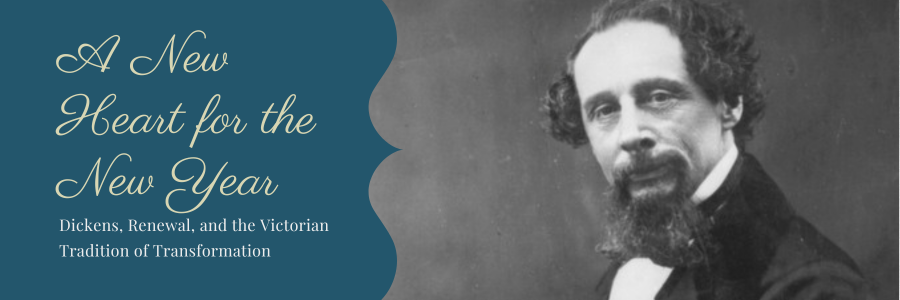
This post is contributed by Melisa Kaya, a graduate with honors in English and Creative Writing from Saint Mary’s University, Canada. As a writer, editor, and researcher, her primary research examines the intersection of literature and science, exploring their mutual influence. Additionally, Melisa engages in various other research projects, including investigations into Victorian movie adaptations and historical perspectives in world literature. Melisa is also a member of the Dickens Society Communications Team.
The New Year has always been a moment of transformation—a threshold where the weight of the past slips away and the future gleams with untold possibilities. For the Victorians, who lived amidst the unrelenting churn of industrial and social upheaval, this moment of renewal was not simply a tradition but a necessity. It offered a chance to pause, to reassess one’s place in a rapidly changing world, and to embrace hope anew. Few captured the spirit of this season—and its connection to moral and personal transformation—more profoundly than Charles Dickens.
Dickens’s works are steeped in the ethos of renewal, from the literal tolling of bells to his characters’ inner awakenings. In The Chimes (1844), a lesser-known but equally resonant successor to A Christmas Carol (1843), Dickens centers the New Year as a time for redemption. The novella’s protagonist, Toby “Trotty” Veck, is a humble ticket-porter weighed down by despair, convinced that the world has left him behind. But when the chimes of a nearby church summon him into a surreal journey of self-discovery, Trotty is shown his worth, the value of hope, and the possibility of a better future. By morning, he returns to his family renewed, embodying the bells’ rallying cry: “A new heart for a New Year, always!” (Dickens, The Chimes).
Dickens and the New Year: Reflections and Resolutions
Dickens’s fascination with renewal extended far beyond fiction; the New Year was a recurring motif in his writings and essays. In an 1836 piece titled The New Year, Dickens painted an ideal picture of the celebration—not a solemn occasion of fasting or introspection, but a lively gathering of friends, music, and conversation. “We cannot but think it a great deal more complimentary, both to the old year that has rolled away, and to the New Year that is just beginning to dawn upon us, to see the old fellow out, and the new one in, with gaiety and glee,” he wrote, emphasizing the importance of welcoming change with optimism and connection rather than somber reflection (Perdue). For Dickens, the New Year was less about lamenting the past than about embracing the future with cheer and connection.
This perspective was not limited to his public writings. Even Dickens’s private reflections echoed the themes of renewal and gratitude that permeate his fiction. On January 1, 1838, he penned a poignant diary entry reflecting on the death of his sister-in-law, Mary Hogarth, who had passed away in his arms the previous year. He wrote, “Very many things to be grateful for, since then,” acknowledging the blessings of good health and professional success while lamenting Mary’s absence. “We never know the full value of blessings ’til we lose them” (Dickens, Diary—1838). For Dickens, the New Year was more than just a time to mourn what had been lost; it was also a chance to honor those losses by carrying forward their lessons—a reminder that even in grief, hope and gratitude offer a chance for reflection.
Resolutions: The Art of Starting Again
If the New Year was a time for reflection, it was also a season for resolutions—a tradition Dickens both chronicled and embodied. For the Victorians, resolutions were more than personal promises; they were moral declarations deeply tied to the era’s emphasis on self-improvement. Evangelical movements and the burgeoning genre of self-help literature championed the idea that change was not only possible but imperative, framing resolutions as acts of personal accountability.
In Dickens’s fiction, resolutions often propel his characters toward profound transformations. Ebenezer Scrooge’s vow to “honor Christmas in my heart, and try to keep it all the year” in A Christmas Carol is perhaps the most famous resolution in English literature (Dickens, A Christmas Carol). Scrooge’s resolution radiates outward, reshaping not only his life but also the lives of those around him. Similarly, Trotty Veck’s renewed determination in The Chimes to face life with optimism underscores Dickens’s belief that even the smallest internal shift can ripple outward to effect change.
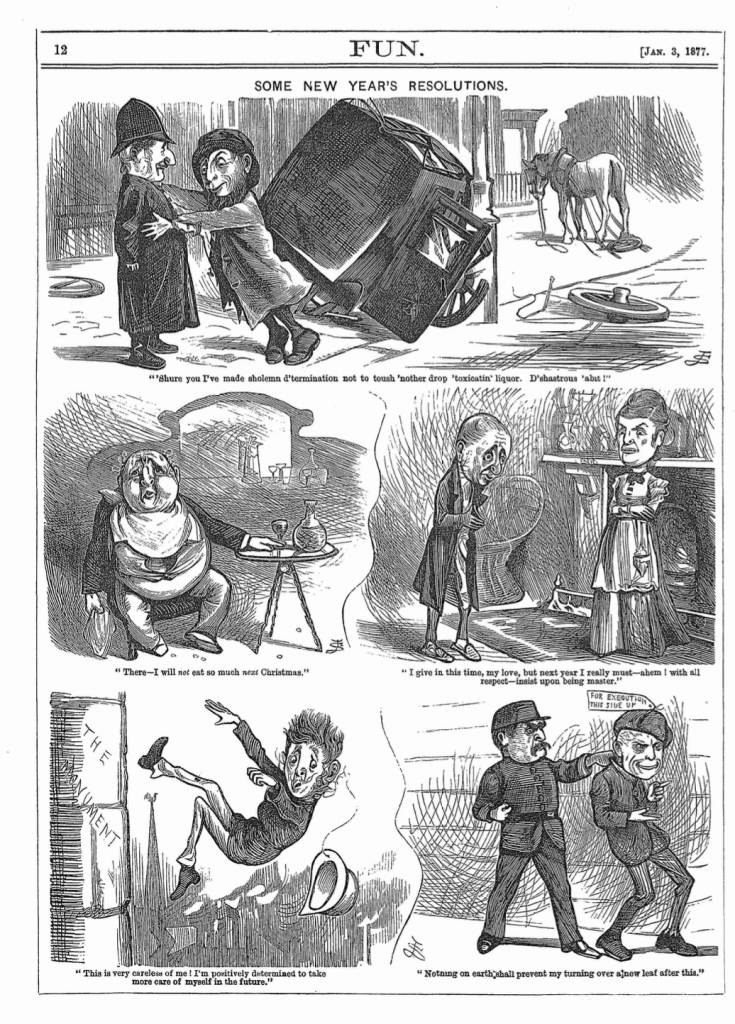
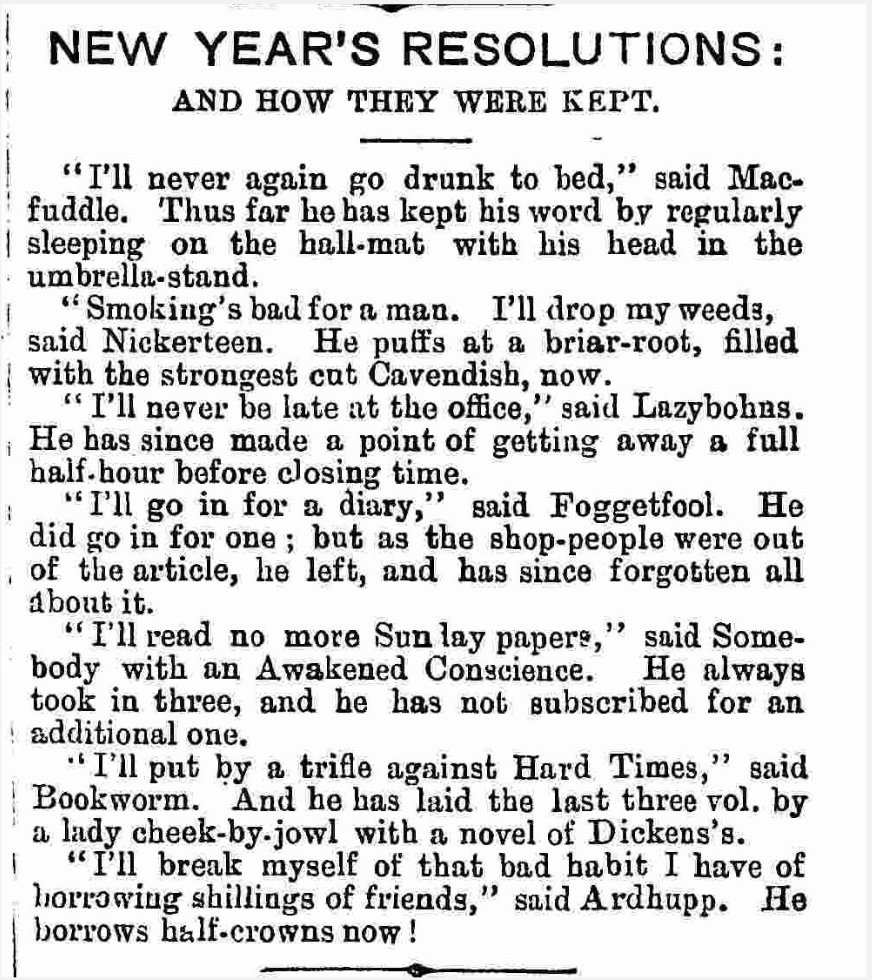
Victorian satirists, however, found plenty to lampoon in the culture of resolution-making. Fun magazine (1877) skewered the tradition with a series of vignettes depicting well-intentioned but laughably doomed pledges: a man vows to give up liquor only after stumbling into a cart accident, clearly worse for wear; another declares, “Nothing on earth shall prevent my turning over a new leaf after this,” while being apprehended for theft. In Funny Folks (1879), another satirical publication, a would-be thrifty gentleman resolves to save money but promptly spends it all on a collection of Dickens’s novels. The humor underscores a deeper truth: resolutions, though often fraught with failure, reflect an enduring hope for growth and renewal.
Crossing the Threshold: First-Footing
The New Year’s theme of renewal extended beyond resolutions to the symbolic act of crossing a threshold. The Scottish tradition of first-footing, widely adopted in Victorian Britain, embodied this idea in a tangible way. At the stroke of midnight, the first person to step over a home’s threshold—the “first-footer”—was believed to set the tone for the year ahead. Ideally, this visitor was a dark-haired man bearing gifts: coal for warmth, bread for sustenance, silver coins for prosperity, and whiskey for cheer. Fair-haired visitors, by contrast, were considered unlucky—a lingering echo of Viking invaders whose arrivals were far from auspicious (“What is First-Footing?“).
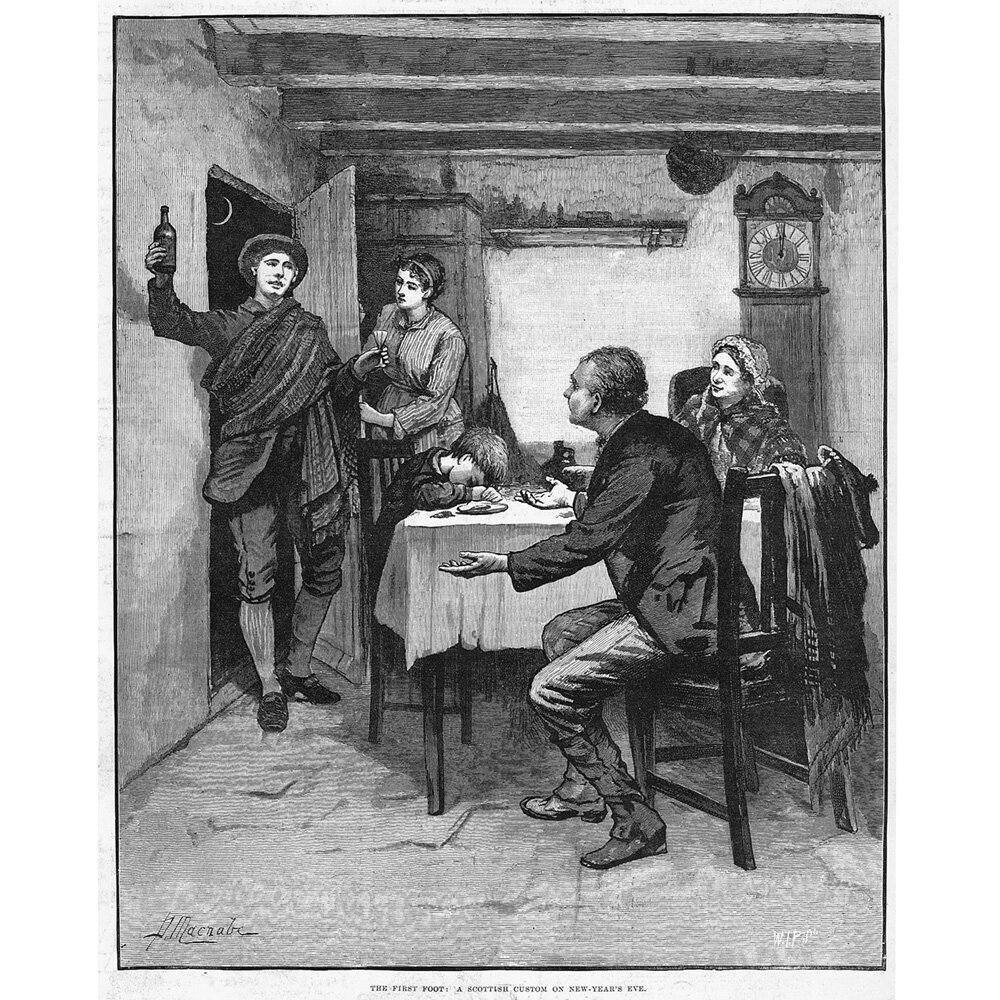
While Dickens does not explicitly reference first-footing, the concept of transformative arrivals is woven deeply into his narratives. Marley’s ghost in A Christmas Carol could be seen as a spectral first-footer, crossing Scrooge’s threshold with an invitation to change—not through tokens of fortune but through the promise of redemption. Similarly, in The Chimes, Trotty Veck becomes his own first-footer, stepping back into his family’s life after his haunting night of visions. Both stories hinge on the idea that a single crossing, whether literal or metaphorical, can alter one’s path entirely.
In Dickens’s world, as in Victorian tradition, thresholds represent more than mere doorways; they mark pivotal moments of change. Whether it’s the symbolic crossing of a home’s threshold in first-footing or the metaphorical steps taken by characters like Scrooge and Trotty Veck, these moments carry the promise of transformation. For Dickens and his contemporaries, the act of crossing over—be it into a new year, a renewed sense of purpose, or a better self—embodied the profound hope that the future could always be reshaped, one deliberate step at a time.
Ringing Out the Old, Ringing in the New
Central to Dickens’s vision of renewal is the tolling of bells, a motif that resonates across his works—from the haunting peals in A Christmas Carol to moments of reflection in David Copperfield and Great Expectations, and even the grave echoes in Bleak House. In The Chimes, however, the bells take on a deeper role. They are not merely timekeepers but moral sentinels, marking the New Year’s arrival and summoning Trotty Veck to reckon with his despair while urging him toward hope. Their chimes herald the passage from one year to the next, embodying the possibility of transformation and the responsibility it entails.
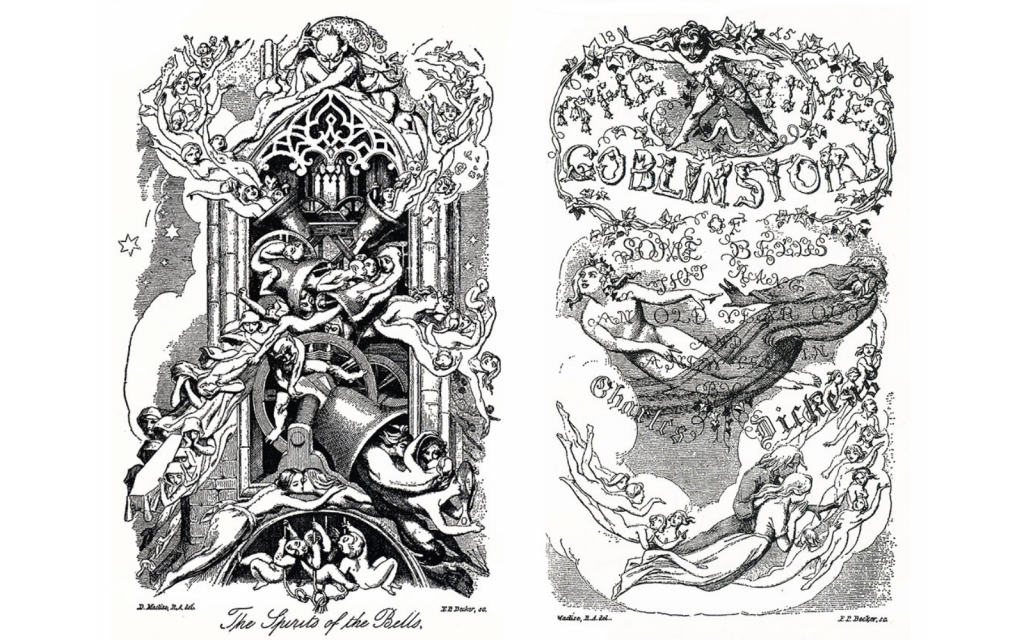
For Dickens, as for his Victorian contemporaries, the act of “ringing out the old” was not merely a farewell to what had passed but a call to embrace the promise of what lay ahead. Tennyson’s famous lines, “Ring out the false, ring in the true,” capture the spirit of this tradition—a sentiment echoed throughout Dickens’s prose, where renewal is both a reflection and a decisive act (Tennyson line 8). Whether expressed through the chimes of a church bell, the crossing of a threshold, or the resolve to save money rather than indulge in another Dickens novel, his message is unmistakable: transformation begins with a single step forward.
And so, with every toll of the bells, Dickens underscores the enduring potential of the New Year—a tangible restart amidst the ceaseless rhythm of daily life, where, like many of his characters, some drift through routines until an unexpected reckoning prompts a moment of clarity. For Trotty Veck in The Chimes, that reckoning comes with the bells, revealing that it is never too late to discover “a new heart for a New Year, always”—a heart that embraces renewal, inspires change, and moves forward with purpose into a future filled with possibility (Dickens, The Chimes).
Works Cited
Dickens, Charles. A Christmas Carol. 1843. Project Gutenberg, 20 Sept. 2006, www.gutenberg.org/files/19337/19337-h/19337-h.htm. Accessed 30 Dec. 2024.
—. Diary—1838. Project Gutenberg, 2008, www.gutenberg.org/cache/epub/25854/pg25854-images.html. Accessed 30 Dec. 2024.
—. The Chimes. 1844. Project Gutenberg, 1 Sept. 1996, www.gutenberg.org/ebooks/653. Accessed 30 Dec. 2024.
Perdue, David. “The New Year.“ The Charles Dickens Page, www.charlesdickenspage.com/the-new-year.html. Accessed 30 Dec. 2024.
Tennyson, Alfred Lord. “Ring Out, Wild Bells.“ The Beauties of Tennyson, illustrated by Frederic B. Schell, Porter & Coates, 1885. Project Gutenberg, 23 Nov. 2007, www.gutenberg.org/files/23597/23597-h/23597-h.htm#RING_OUT_WILD_BELLS. Accessed 30 Dec. 2024.
“What is First-Footing?“ National Coal Mining Museum, 2 Jan. 2022, www.ncm.org.uk/news/what-is-first-footing/. Accessed 30 Dec. 2024.
